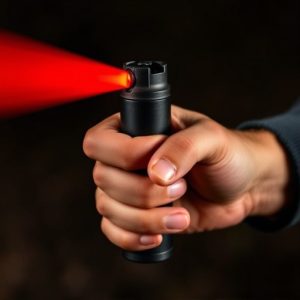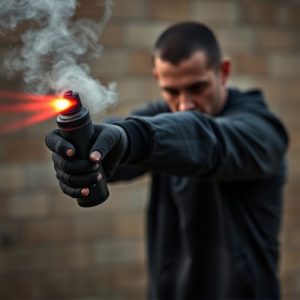Capsaicin Protection: Spray, Move, & Stay Safe with Innovative Devices
Capsaicin, the spicy compound in chili peppers, offers a novel non-lethal self-defense solution thro…….
Capsaicin, the spicy compound in chili peppers, offers a novel non-lethal self-defense solution through specialized sprays. The 'Spray and Move' deployment technique enables users to quickly incapacitate attackers while maintaining mobility, creating a safety buffer zone. This strategy minimizes direct contact with the capsaicin spray, ensuring maximum effectiveness without collateral damage. However, ethical considerations and strict regulations around capsaicin products are crucial to prevent misuse and ensure user safety during deployment of these game-changing personal protection devices.
“Unveiling a revolutionary personal protection device powered by nature’s potent compound, capsaicin. This innovative solution offers a unique approach to safety with its spray-and-move deployment technique. The article delves into the science behind capsaicin as an active ingredient, exploring its benefits in personal defense. We’ll dissect the key components, from understanding the chemical reaction it induces to examining design considerations for optimal delivery. Additionally, we’ll navigate safety protocols and ethical implications, ensuring an informed discussion on this game-changing self-defense tool.”
- Understanding Capsaicin: The Active Ingredient
- Benefits of a Capsaicin-Based Personal Protection Device
- Spray and Move Deployment Techniques Explained
- Design Considerations for Effective Delivery
- Safety, Regulations, and Ethical Implications
Understanding Capsaicin: The Active Ingredient
Capsaicin, the active ingredient in many spicy foods, is a powerful compound that has found new life in personal protection devices. When incorporated into spray formulations, capsaicin offers an innovative and non-lethal self-defense solution. Its unique properties make it an effective deterrent when deployed using advanced spray and move techniques.
These techniques involve strategic application of the capsaicin spray, ensuring maximum impact while minimizing potential harm to bystanders. The quick deployment of such devices allows individuals to create a buffer zone, providing precious time to escape or de-escalate a threatening situation. This natural ingredient’s ability to induce a burning sensation and disorient a perceived threat makes it a game-changer in personal safety devices, especially for those seeking alternative options to conventional weapons.
Benefits of a Capsaicin-Based Personal Protection Device
A capsicum-based personal protection device offers a non-lethal yet highly effective approach to self-defence, providing users with an added sense of security in potentially dangerous situations. One of its key advantages is the use of capsaicin, the compound responsible for the heat sensation in chilli peppers. When deployed as a spray, it can quickly incapacitate an attacker, giving the user valuable time to escape and seek help. This immediate impact is particularly beneficial in close-quarters confrontations.
The versatility of these devices is further enhanced by different deployment techniques, such as spray and move. This strategy allows users to apply the spray from a safe distance while retreating, ensuring they maintain mobility and avoid direct contact with the aggressor. Such tactical options make capsaicin-based protection devices appealing for individuals seeking an affordable and accessible personal safety solution that complements traditional self-defence training.
Spray and Move Deployment Techniques Explained
When using a capsaicin-based personal protection device, the Spray and Move deployment technique is a powerful strategy. This method involves quickly spraying the irritant agent while simultaneously moving away from the threat. The key is to apply the spray in a swift, controlled manner, covering the target area while keeping a safe distance. This technique is ideal for self-defense scenarios as it enables the user to create a barrier and retreat, providing crucial time to escape potential danger.
The effectiveness of this approach lies in its speed and efficiency. By moving immediately after spraying, users can minimize direct contact with the irritant, ensuring their safety while temporarily disabling the assailant. This deployment technique is particularly useful in close-quarter encounters, allowing individuals to defend themselves and quickly create distance from a hostile situation.
Design Considerations for Effective Delivery
When designing a capsaicin-based personal protection device, the key lies in effective delivery systems. One promising approach is employing Spray and Move deployment techniques. These methods ensure rapid application of the capsaicin spray, allowing users to quickly create a buffer zone when facing potential threats. The design should prioritize ease of use, with a focus on triggers that are sensitive yet robust, ensuring quick response times without accidental activation.
Additionally, the device’s size and weight are crucial factors. A compact and lightweight design facilitates easy carriage, making it accessible for personal protection in various settings. Incorporating advanced nozzles and ventilation systems can further enhance coverage, ensuring the capsaicin spray reaches its target accurately and efficiently.
Safety, Regulations, and Ethical Implications
The safety of capsaicin-based personal protection devices, often in the form of sprays, is a key consideration. These products, designed to deter and incapacitate assailants, must adhere to stringent regulations to ensure they do not cause unnecessary harm or suffer misusage. The active ingredient, capsaicin, can have severe health impacts if not handled properly, leading to ethical debates around their production, distribution, and use.
When employing spray and move deployment techniques, users must be trained adequately to minimize collateral damage. Regulations dictate the concentration levels of capsaicin allowed in these devices to prevent long-term health effects on individuals who might accidentally come into contact with them. Moreover, ethical implications arise from the potential for abuse or misuse, underscoring the importance of responsible manufacturing practices and user education to promote safe and legal use.
A capsaicin-based personal protection device offers a unique and effective approach to safety, leveraging the power of this natural compound. By employing the Spray and Move Deployment Techniques, users can quickly defend against potential threats while enjoying numerous benefits, such as non-lethal deterrence and minimal harm to bystanders. However, it’s crucial to consider safety, regulations, and ethical implications to ensure responsible use in public spaces. With proper design and adherence to guidelines, these devices have the potential to revolutionize personal protection, providing individuals with an extra layer of security in today’s diverse and dynamic world.


